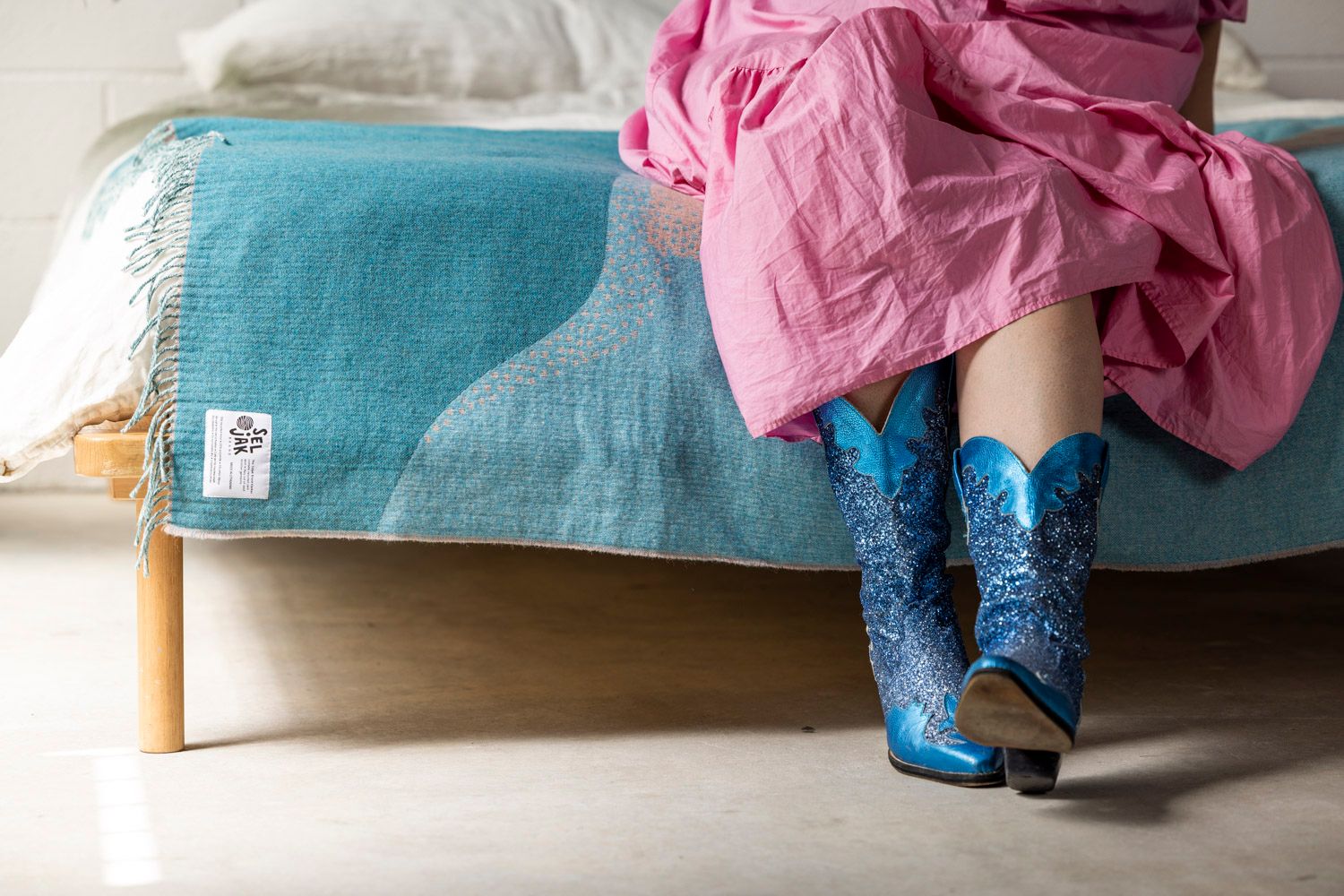 Dr Anna Hickey for the Seljak Brand Passage blanket launch
Dr Anna Hickey for the Seljak Brand Passage blanket launch
Dr Anna Hickey advocates for a fashion industry that embraces everybody regardless of identity, gender, body or ability. She is one sixth of Meanjin’s The Stitchery Collective, is a public programmer at the Gallery of Modern Art and the model in our Passage blanket photoshoot. Not only do we love her for celebrating diversity and accessibility, we are inspired by the playful creativity she brings to fashion. We asked Anna a few questions to learn more about her work with The Stitchery Collective and how fashion can be a social act.
 Anna with the Passage blanket and Portal, an artwork by Karina Seljak that fell out of the design process
Anna with the Passage blanket and Portal, an artwork by Karina Seljak that fell out of the design process
What is The Stitchery Collective? Tell us about your involvement.
The Stitchery Collective is a design collective started in 2010 that creates artworks, public engagement and research about fashion. We don't make or sell clothing, but instead we are interested in all the other ways we experience clothing and fashion. I was one of the founding members back in 2010, and have been a key part of the 12 years (and counting) of work we have produced. I particularly help in the Public Programs we design for institutions and festivals. Our most recent Stitchery event was the 'Bowerytopia' party, which is the fourth in a series of radical dress up parties celebrating queer fashion icon Leigh Bowery.
 Anna shot by Georgia Wallace from The Stitchery Collective’s Bowerytopia party portraits
Anna shot by Georgia Wallace from The Stitchery Collective’s Bowerytopia party portraits
 Nick, Eden and Anna at The Stitchery Collective’s Bowerytopia
Nick, Eden and Anna at The Stitchery Collective’s Bowerytopia
What does The Stitchery Collective celebrate?
The Stitchery celebrates the joyful, meaningful and rich ways that we all connect with clothing. Fashion often gets a bad wrap from the high-consumption and low-ethics world of the contemporary fashion system, but as many of us already know, our connection to cloth and the wearing of textiles is much more complex and nuanced than just 'materialism'. Clothing and textiles have memories, history and human emotion embedded in them. They are a unique creative product that every human is forced to intimately engage with. The Stitchery is really about exploring, in a more conceptual way, all of those lovely relationships and feelings we form around clothing. We might do this through dress up parties, workshops, public lectures, research papers, exhibitions, collaborations with companies, and interactive installations, and we love exploring in what ways these feelings can be shared amongst our community.
How can we make fashion spaces more inclusive?
Fashion has a lot to answer for when it comes to exclusionary standards, especially in visual culture. Fashion spaces can be more inclusive by promoting identities, bodies and imagery that actually reflects the real diversity of human life. I've always had the personal opinion (change my mind!) that if a brand relies solely and conspicuously on slim, young, able-bodied, eurocentrically beautiful and heteronormatively gendered white folk to 'sell' their garments or products, then they are either 1) lazy stylists or 2) uninteresting products. Every type of body has a place in fashion and in visual culture, and thankfully lots of brands are figuring this out. To become more inclusive, the people who are designing within fashion spaces need to keep pushing back on industry standards – from small brands through to high fashion houses. I personally love seeing so many great brands using a diverse array of models – it's so affirming to see myself and many other identities reflected in their beautiful campaigns! (Love your work Seljak!)
 Anna Hickey wrapped up in our Passage blanket
Anna Hickey wrapped up in our Passage blanket
What does sustainable fashion mean to you?
Sustainable fashion means a lot of things to me, but above all, it means an attitude to valuing and caring for garments and textiles. It also means meeting people where they are at on their journey – there will always be barriers to people accessing sustainable fashion, but I believe, when you can do better, you should. 'Doing better' means making informed and thoughtful purchasing choices, it means caring for your garments correctly, and it means taking responsibility for the whole lifecycle of a garment you purchase.
 Anna wearing a dress she found at Swop and her pride and joy – vintage blue sparkly cowgirl boots
Anna wearing a dress she found at Swop and her pride and joy – vintage blue sparkly cowgirl boots
How is fashion and community inextricably linked?
Fashion is linked to community in so many ways because fashion has always been an important vehicle for identity. How we dress ourselves inevitably connects us to social groups but at the same time, defines us as individuals. Further to this, playing with fashion can help us to assert an identity we want to claim – a gender, a cultural background, a personality trait. When we are in tune with our own style, we use fashion to adorn our 'self', to connect to others, and even to live and breathe our values. This is important because it means that fashion can be a medium through which individuals and brands can try to bring about change, and that is incredibly useful in the current climate.
 Anna’s signature boots side-by-side with the Passage blanket
Anna’s signature boots side-by-side with the Passage blanket
Read more about The Stitchery Collective and follow @thesticherycollective to get involved with their future events.

